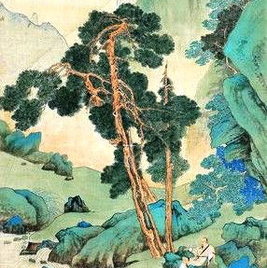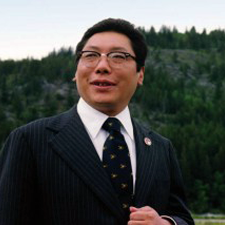Contemplative Arts
Contemplative Arts comprise a number of secular disciplines and activities, including calligraphy, flower arranging, haiku, kyudo, and photography, that integrate art and culture with everyday life. Each of these disciplines represents a genuine contemplative path. Each one brings beauty, vividness and wisdom to our lives and the world.
Here at Sky Lake we have a number of teachers of Dharma Art who present these teachings through movement, music, visual art and poetry.
In the wider Shambhala world, there are offerings of Kyudo Archery, Ikebana Flower Arranging, Miksang Photography and Shambhala Art. For more information visit Shambhala Art.
Dharma Art
When Chögyam Trungpa first started teaching Buddhism in the United States, he had a much larger vision for the implementation of Buddhist culture that could be incorporated into western culture. In this vision he could see that all the major design disciplines that define culture – architecture, fashion, industrial design, graphic design, interior design – as well as fine arts – poetry, painting, calligraphy, theater, music – could integrated with the Buddhism, and be endowed with a new look that would define the societal transformation that would naturally incorporate the Buddhist teachings into the western world.
In the early 1970’s, when Trungpa start teaching in the USA, there was no Buddhism in American culture. There were no books, no teachers, no temples. In the very beginning, Trungpa didn’t teach Buddhism, though he taught the essence of Buddhism through art. These methods are now called the Dharma Art teachings, and can be learned through various methods such as Shambhala Art, Mudra Space Awareness, Maitri Space Awareness, and Visual Dharma.
Although Shambhala is a institution of Buddhist teachings and way for people to enter into the vast resources of mindfulness practices, it is a culture that presents a way for the essence of these teachings and practices to be incorporated into ordinary culture. This includes yearly holidays, cultural songs, dances, and rituals that define Shambhala from other Buddhist traditions.

“Calligraphy is a picture of the mind.” Ancient Chinese saying
Calligraphy: Making a Mark
Drawing on the Asian principles of heaven, earth and human, the Big Brush workshop makes visible the natural order of the present moment, revealing how we show up in our life and express who we are. Held within a simple ritual, working with large horsehair brushes, big sheets of paper and buckets of ink, we can sense what it means to make a true mark and bring forth a natural and unending creativity.
See also : Embodied Mark Making
Kalapa Ikebana: The Art of Flower Arranging
In 1982, Chögyam Trungpa formed a new school of ikebana (Japanese flower arranging) inspired by his own training in the Sogetsu School of Ikebana and the Shambhala vision. Kalapa Ikebana – is a contemplative practice that mixes these traditional Japanese teachings with mindfulness.
Music
Sky Lake has been a place of musical exploration within the context of meditation practice and the Dharma. Within the greater community of Sky Lake and Shambhala there have been many enterprises to explore and teach this incorporation of path and music, including (but not limited to) The Creative Music Workshop by the late Jerry Granelli, the Creative Music Studio in Woodstock, the Mindful Rhythm Method by Andrew Forbes, Meditation for Musicians by Brian Wade, and the Dharma of Sound with Steve Gorn.
It can be easily said that music is a spiritual path in itself, and an easy way to connect with the essential principles of dharma. The threefold expression of Heaven, Earth, and Human as stated below can be explored vividly through the practice of music.
Sky Lake hosts outdoor concerts in the warmer months in our majestic pond amphitheater.
Sky Earth Heart: A Threefold Path
Exploring the Heaven Earth & Human teachings of Chogyam Trungpa can be done with brush or pencil or pen. Here is a simple writing practice guided by these principles.
Sit or stand by a window with pen and paper near by.
Look out and see what you notice.
Let your eyes relax and allow something to come to you.
Note something you see in the sky –
or flying through – or drifting in the space.
Describe this in a short phrase or sentence and write it down.
Then look down and note something that is on the ground
or growing from the earth.
Describe this simply.
Wait until something small – a detail – draws your attention.
Describe this.
Lacework of branches against white clouds
Soft expanse of green grass not growing yet
Empty bird feeder waiting to be filled again.
Read the three lines back to yourself and notice how you feel.
For more examples go to Sky Earth Heart
Miksang Photography
Miksang is a Tibetan word that means “good eye.” A contemplative art, it is based directly on the Dharma Art teachings of the late meditation master, artist and scholar, Chögyam Trungpa, specifically by his teachings on the nature of perception. The “good” refers to our world, just as it is, is inherently rich and vivid. The “eye” reference is that in working with the practice of contemplative photography, we can tune into these qualities of our world. This journey is actually quite simple-to see with our eyes wide-open and our awareness right there. Once we have a moment of fresh perception, vivid and clear, there is a natural desire to communicate that experience. Through visual exercises and photographic assignments, Miksang is designed to allow the eye and the mind to be naturally synchronized, so that the experience of seeing could be undistracted and present.
See also: www.miksang.com Photo by Julie DuBose







